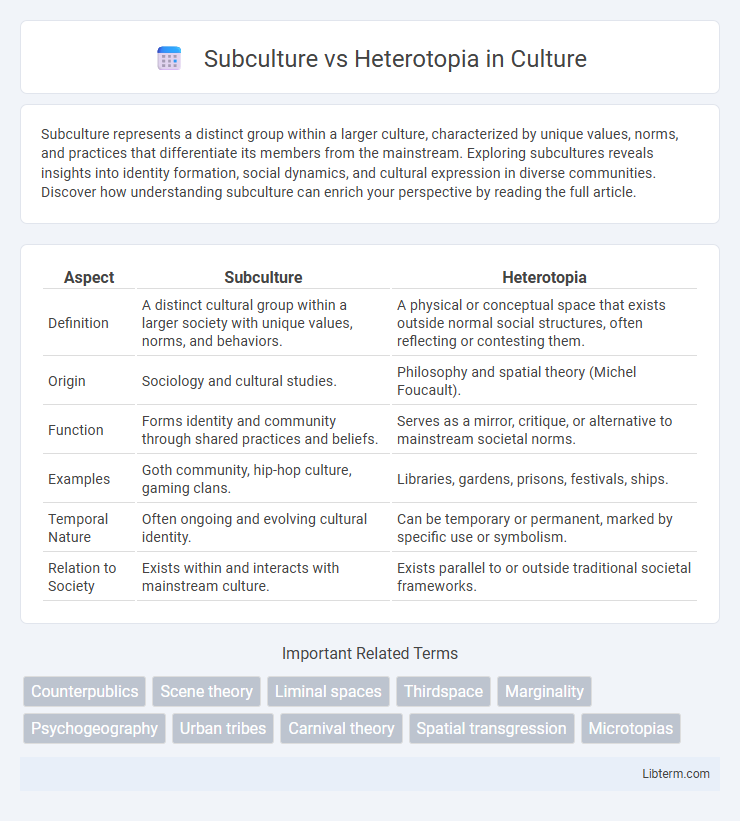Subculture represents a distinct group within a larger culture, characterized by unique values, norms, and practices that differentiate its members from the mainstream. Exploring subcultures reveals insights into identity formation, social dynamics, and cultural expression in diverse communities. Discover how understanding subculture can enrich your perspective by reading the full article.
Table of Comparison
| Aspect | Subculture | Heterotopia |
|---|---|---|
| Definition | A distinct cultural group within a larger society with unique values, norms, and behaviors. | A physical or conceptual space that exists outside normal social structures, often reflecting or contesting them. |
| Origin | Sociology and cultural studies. | Philosophy and spatial theory (Michel Foucault). |
| Function | Forms identity and community through shared practices and beliefs. | Serves as a mirror, critique, or alternative to mainstream societal norms. |
| Examples | Goth community, hip-hop culture, gaming clans. | Libraries, gardens, prisons, festivals, ships. |
| Temporal Nature | Often ongoing and evolving cultural identity. | Can be temporary or permanent, marked by specific use or symbolism. |
| Relation to Society | Exists within and interacts with mainstream culture. | Exists parallel to or outside traditional societal frameworks. |
Understanding Subculture: Definition and Key Characteristics
Subculture refers to a distinct group within a larger society that differentiates itself through unique values, norms, styles, and behaviors, often expressed via fashion, music, language, and social practices. Key characteristics include shared beliefs, a sense of identity and belonging, and resistance to mainstream cultural norms, forming a cohesive community with its own symbolic meanings. Unlike heterotopia, which are physical or conceptual spaces representing alternate realities, subcultures primarily exist through social interaction and cultural expression.
Heterotopia Explained: Origins and Theoretical Framework
Heterotopia, a term coined by philosopher Michel Foucault in 1967, refers to real-world spaces that exist outside of typical social and spatial norms, embodying otherness and layered meanings. These spaces, such as cemeteries, museums, and gardens, function as sites of juxtaposition where multiple incompatible spaces coexist, challenging conventional spatial logic. Foucault's theoretical framework positions heterotopias as counter-sites that reflect and contest societal structures, offering critical insights into the organization of space and human experience distinct from subcultures, which primarily form around shared social practices and identity.
Historical Contexts: Evolution of Subculture and Heterotopia
Subculture emerged prominently in the mid-20th century as a response to industrialization and mass consumer culture, reflecting youth resistance and alternative identities within societies. Heterotopia, a concept introduced by Michel Foucault in 1967, refers to spaces that exist outside conventional social orders, embodying historical layers and cultural contradictions. The evolution of subculture highlights collective social practices adapting to modernity, while heterotopia emphasizes spatial ruptures that reveal hidden or opposed realities within historical contexts.
Cultural Spaces: Where Subcultures and Heterotopias Intersect
Cultural spaces serve as dynamic sites where subcultures and heterotopias intersect, creating environments that challenge mainstream societal norms through distinct spatial practices. Subcultures shape these spaces by embedding unique values, symbols, and rituals that foster identity and resistance within heterotopic contexts, which exist as alternative, layered realities reflecting and contesting dominant culture. The interplay between subcultural expression and heterotopic spatial arrangements underscores the transformative potential of cultural spaces in redefining social boundaries and power structures.
Social Identity Formation in Subcultures vs Heterotopias
Social identity formation in subcultures revolves around shared values, symbols, and practices that distinguish members from mainstream society, fostering a sense of belonging and collective identity. Heterotopias, by contrast, create spaces of otherness where multiple identities coexist and interact, challenging dominant social norms through spatial and temporal disruptions. Subcultures emphasize cohesive identity construction within defined groups, while heterotopias facilitate fluid, overlapping identities shaped by the juxtaposition of diverse social realities.
Representation in Media: Subculture and Heterotopia Narratives
Representation in media often distinguishes subcultures as distinct social groups with unique styles, values, and practices, emphasizing identity formation and resistance within mainstream culture. Heterotopia narratives portray spaces that juxtapose multiple realities or social orders simultaneously, creating layered, often contradictory environments that challenge conventional perceptions of space and society. Media depicting subcultures highlights collective agency and alternative lifestyles, whereas heterotopia narratives explore spatial and symbolic heterogeneity, revealing complexities in social order and cultural representation.
Resistance and Conformity: Power Structures in Both Worlds
Subcultures resist dominant cultural norms by creating alternative spaces and identities that challenge mainstream power structures, fostering collective autonomy and dissent. Heterotopias, as described by Foucault, function as real-world 'other spaces' where societal rules are simultaneously enacted and subverted, reflecting both conformity and resistance within complex power dynamics. Both frameworks reveal how power operates through resistance and conformity, illuminating tensions between individual agency and structural control in cultural and spatial practices.
Architectural and Physical Manifestations
Subcultures often shape architectural and physical spaces by transforming everyday environments into sites of identity and resistance, using graffiti, posters, and modified interiors to express ethos and values. Heterotopias manifest as distinct, often enclosed or isolated spaces such as cemeteries, gardens, or museums, embodying multiple layers of meaning and functioning as heterotopic counter-sites that juxtapose or invert societal norms. Both concepts emphasize spatial practices, but subcultures actively appropriate and personalize spaces, whereas heterotopias represent pre-existing, culturally coded locations that challenge conventional perceptions of space and time.
Impacts on Mainstream Culture and Society
Subcultures influence mainstream culture and society by introducing alternative values, styles, and practices that challenge dominant norms and inspire innovation in fashion, language, and art. Heterotopias create distinct social spaces that reflect, contest, or invert real-world cultural orders, offering critical perspectives that encourage societal reflection and transformation. Both concepts contribute to cultural diversity by disrupting homogeneity and fostering dialogue about identity, community, and power structures within society.
Future Trends: The Blending of Subculture and Heterotopia
Future trends indicate a dynamic blending of subculture and heterotopia, where digital platforms become immersive spaces fostering unique social groups and alternative realities. Virtual environments like metaverses serve as heterotopias, enabling subcultures to form distinct identities beyond physical constraints. This integration accelerates cultural innovation and challenges traditional notions of space and community in contemporary society.
Subculture Infographic

 libterm.com
libterm.com